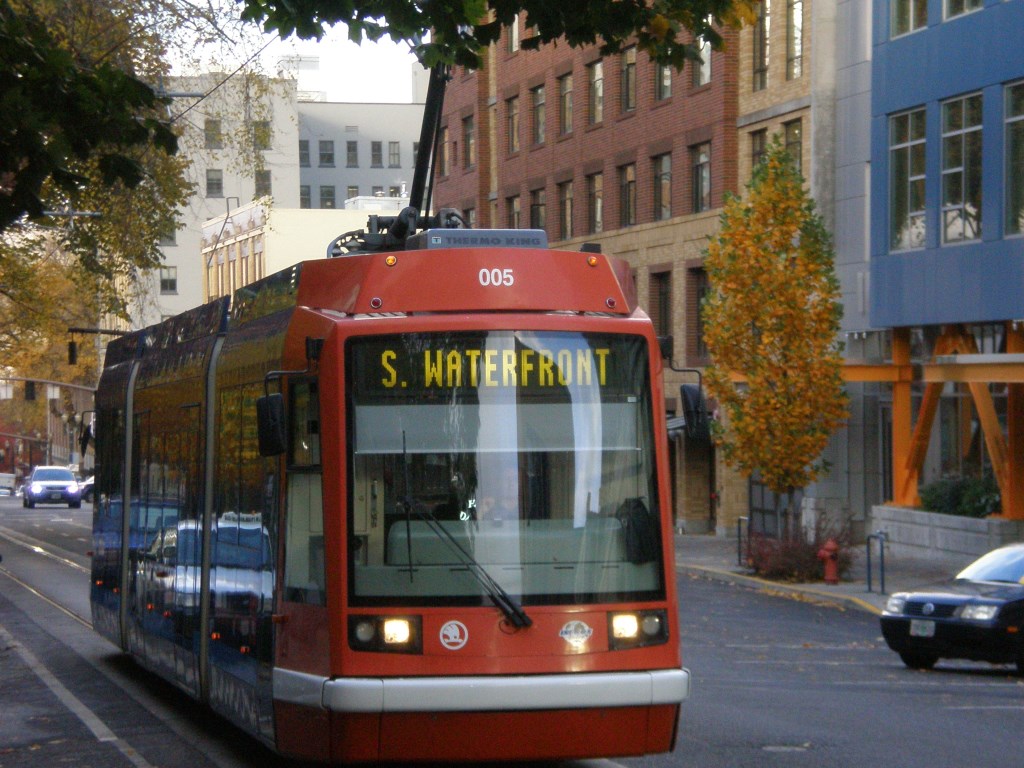Amid declining transit ridership nationwide, Portland Streetcar sets ridership record in April
The Portland Streetcar averaged 16,650 weekday riders in April
Portland, Ore.—The Portland Streetcar averaged 16,650 weekday riders in April, setting a record for the city’s 17-year-old system. The high watermark for Portland Streetcar represents a contrast to declining transit ridership in most major cities across the country. Cities that are seeing ridership increase, like Seattle and Houston, are investing in their transit networks by improving service, redesigning networks, and implementing new technology.
“The Streetcar’s success in moving people through and around the central city is clearer than ever,” said Portland City Commissioner Dan Saltzman. “With ridership growing, the Streetcar remains an important tool to fight congestion in our growing city.”
The Streetcar averaged on-time performance of 84 percent in April. The Portland City Council recently approved the purchase of two new cars to add frequency and reliability to the system. Those cars are being built by Brookville Equipment Corporation and are expected to enter service in 2020. In 2017, Portland Streetcar also partnered with Tri-Met and C-TRAN to launch Hop Fastpass, an electronic fare payment system that allows riders to pay with contactless cards or mobile devices.
The previous highest average weekday ridership was 16,351 in February 2017. The Portland Streetcar has provided more than 56 million rides since opening in 2001 and now serves 4.7 million riders per year. Overall ridership increased 9.3 percent in 2017, with nearly the entire increase occurring on the east side.
Daily ridership averages by line:
NS Line: 9,226
A/B Loop: 7,424
When the Portland Streetcar began service in 2001, it was the first of the country’s modern streetcar systems. Over the past 15 years, more than 10 American cities have followed suit and built their own streetcars, with new systems about to open in El Paso, Milwaukee, Oklahoma City, and Tempe. Portland Streetcar’s daily ridership is expected to grow to 20,000 riders by 2025.
For more information on Portland Streetcar statistics and performance, go to: https://portlandstreetcar.org/about-us/ridership-performance
NOTE: This press release was submitted to Urban Milwaukee and was not written by an Urban Milwaukee writer. While it is believed to be reliable, Urban Milwaukee does not guarantee its accuracy or completeness.
Mentioned in This Press Release
Recent Press Releases by Portland Streetcar
Amid declining transit ridership nationwide, Portland Streetcar sets ridership record in April
May 15th, 2018 by Portland StreetcarThe Portland Streetcar averaged 16,650 weekday riders in April
Along Portland’s streetcar route, each new housing unit adds a regular streetcar rider
Oct 6th, 2016 by Portland StreetcarNew data offers insight into future demand for streetcar systems around the country.
Who Rides the Portland Streetcar?
Nov 17th, 2015 by Portland StreetcarSince it began operation in 1998, the streetcar has become a critical part of Portland’s evolution as a connected community.

























Check-out Detroit’s experience.
https://www.bridgemi.com/detroit-journalism-cooperative/one-year-detroits-qline-falling-well-short-expectations
One of the follow-up articles is interesting :
Along Portland’s streetcar route, each new housing unit adds a regular streetcar rider.
That would indicate to me that for the Milwaukee streetcar to succeed, the sooner MORE lines can be installed, particularly through Walkers Point to Bay View, much further northeast to UWM and west on State St to Wauwatosa and the Medical complex, the better and more used the system will be. It needs to go to where average people live who need an easy alternative to driving and parking downtown. The biggest problem ( as indicated in the Detroit article) is that the tram shares the same footprint as cars, which means the cars are creating the problem, not the tram. What about a tram running up the Menomonee valley on it’s own footprint (no cars) connecting Summerfest to Potawatomi to the Domes, Stadium, State Fair, and the Zoo, where cars could be parked in the public lots NOT being heavily used on a given day so folks could leave their cars and ride to the venue that IS being used?
Hopefully the State Legislature will decide to allow Milwaukee to start adding taxes as they see fit. Then Milwaukee could add a separate line-item on Property Tax bills, or a sales tax, dedicated specifically to streetcar route and service expansion.
If the public and businesses are excited about this, it should be greeted with open arms.